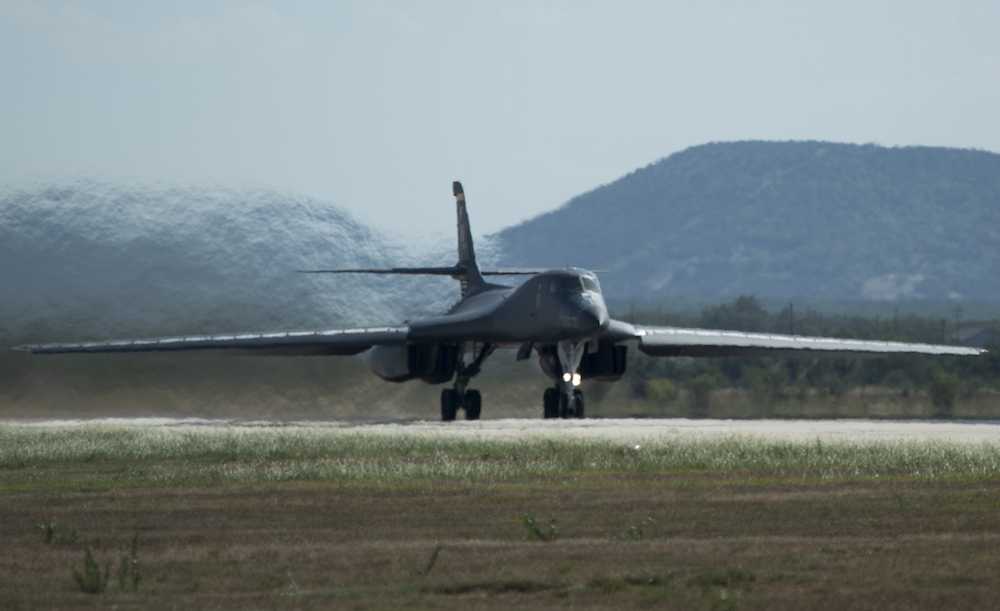
A B-1 bomber takes off from Dyess AFB, Texas, Oct. 2, 2014. Air Force photo by SrA. Peter Thompson.
May 18, 2015—David Shear, assistant defense secretary for Asian and Pacific security matters, stirred diplomatic emotions last week when he mistakenly said B-1B bombers would go to Australia as part of the Defense Department’s efforts to boost US military capabilities in the Asia-Pacific region.
“We will be placing additional Air Force assets in Australia, … including B-1 bombers and surveillance aircraft,” he told the Senate Foreign Relations Committee on May 13 during a hearing on safeguarding American interests in the East China Sea and South China Sea. He did not specify the type of surveillance airplanes.
Talk of sending B-1s to Australia as part of the ongoing US force realignments was new, at least in the public sphere. It didn’t take long for nations in the region to respond, and for US officials to clarify the comment.
“China will resolutely uphold its territorial sovereignty. We demand the relevant side talk and act cautiously and not take any actions that are risky or provocative to maintain regional peace and stability,” said Chinese foreign ministry spokeswoman Hua Chunying in Beijing on May 14, reported Morning News USA.
Of note, China is the same nation pursuing an aggressive policy of land reclamation in the South China Sea area—behavior US officials have called provocative and a backdoor way of taking de facto control of strategic waterways there.
Shear’s comments also prompted the US Embassy in Canberra to post a tweet on May 14: “Contrary to reports, and to correct the record, the US has NO plans to rotate B-1 bombers or surveillance aircraft in Australia.”
Australian Prime Minister Tony Abbott, also commented that day, stating, “I understand that the official misspoke and that the US does not have any plans to base those aircraft in Australia,” reported the Australian Broadcasting Corporation.
However, the US embassy also noted this: “With respect to US force posture initiatives in Australia—which were first announced in 2011—we are currently exploring a range of options for future rotations with our Australian counterparts, and the specifics of future force posture cooperation have yet to be finalized.”
As part of the current force posture initiatives, the Air Force already has sent B-52s to northern Australia on several occasions for short training stints.
When seeking more information on the B-1s and a potential role in Australia, the Air Force referred Air Force Magazine to the Office of the Secretary of Defense.
OSD spokesman Marine Corps Lt. Col. Jeffrey Pool reiterated on May 15 that Shear “misspoke.” US officials “regret any concern or confusion this statement may have caused,” said Pool.
He added, “We have since officially corrected the record to read: ‘We will be operating a mix of additional Air Force assets in Australia on a rotational basis, including fighter, bomber, and tanker aircraft.'”
B-1s have been in Australia before. For example, several B-1s took part in an Australian training exercise in 2006. And they flew there in 2009 for an air show.
Defense Department leadership has spoken in the past several years of bringing back a periodic B-1 presence to the Asia-Pacific region by reintegrating B-1s into the rotational deployments of bombers to Andersen AFB, Guam.
B-1s were initially part of those rotations in the mid-2000s, along with B-2s and B-52s, but then removed from them when combat operations heated up in Afghanistan and Iraq. B-1s played an enduring role in those conflicts as they do today in the air campaign against ISIS terrorist forces in Iraq and Syria.
In May 2014, B-1s flew from home base in South Dakota to drop ordnance on a training range near Guam, so they have not been entirely absent from the Asia-Pacific region in recent years.
